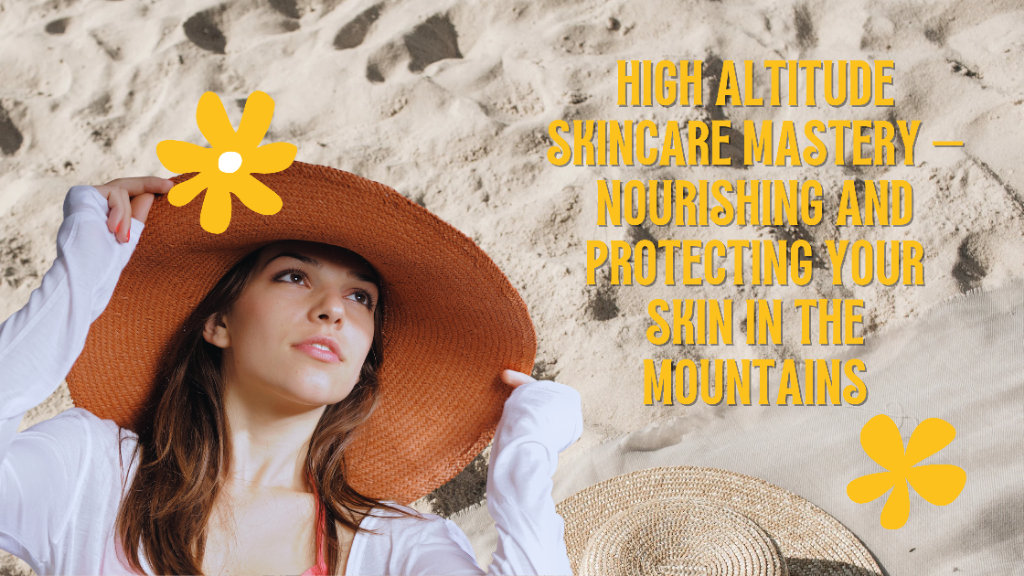
High Altitude Skincare Mastery – Nourishing and Protecting Your Skin in the Mountains
Introduction to High Altitude Skincare
In the serene yet challenging environment of high-altitude areas, skincare transcends the routine—it becomes an essential armor. The thin mountain air and intense UV rays demand more than just occasional attention; they require a dedicated and informed approach to skin health. This article delves deep into the world of high altitude skincare, offering insights and strategies to keep your skin radiant and resilient, even as you live among the clouds.
Understanding the Impact of High Altitude on Skin
At elevated altitudes, the air thins, and the blanket of atmospheric protection diminishes. This reduction in atmospheric pressure makes the air less dense, leading to lower oxygen levels and drier conditions. Such an environment accelerates water loss from the skin, leading to dehydration and a heightened sensitivity.
Moreover, for every 1,000 meters ascended, UV levels increase by approximately 10-12%. This increased exposure to UV rays can accelerate skin aging, causing more pronounced wrinkles and sunspots, and heightening the risk of skin cancer. Understanding these unique conditions is the first step in crafting an effective high altitude skincare routine.
Essential Skincare Steps for High Altitude Living
Crafting a skincare routine for high-altitude living involves three critical steps: cleansing, moisturizing, and sun protection.
- Cleansing: In high-altitude areas, a gentle yet effective cleanser is key. It should be potent enough to remove dirt and impurities but gentle enough not to strip the skin of its natural oils, which are vital for maintaining the skin's protective barrier.
- Moisturizing: Given the dry air, a robust moisturizing regimen is non-negotiable. Look for products rich in ingredients like hyaluronic acid, which can hold up to 1000 times its weight in water, ensuring deep and lasting hydration. Nighttime moisturizing is particularly important, as it helps repair and rejuvenate the skin while you sleep.
- Sun Protection: Sunscreen is your skin's best friend at high altitudes. A broad-spectrum sunscreen with an SPF of 30 or higher should be a staple in your daily routine, applied liberally and regularly. Don't forget areas like the lips and under the eyes, which are particularly susceptible to UV damage.
Key Ingredients for High Altitude Skincare Products
When selecting skincare products for high altitudes, certain ingredients stand out for their efficacy:
- Hyaluronic Acid: Excellent for hydration, it helps to retain moisture in the skin.
- SPF: Essential for protecting the skin from the intense UV rays at high altitudes.
- Antioxidants: Ingredients like vitamin C and E combat free radicals, reducing the risk of skin damage from UV exposure.
- Ceramides: These help to strengthen the skin's barrier, reducing moisture loss and protecting against environmental aggressors.
By integrating these ingredients into your skincare routine, you're not only addressing the immediate concerns of dryness and UV exposure but also investing in the long-term health and youthfulness of your skin.
UV Protection Strategies at High Altitudes
Dealing with Skin Dehydration and Dryness
- Protecting your skin from UV radiation becomes crucial in high-altitude locations because the air protective blanket is weaker. Here's how to guarantee UV protection that works:
- Select Wide-Spectrum Sunscreens. Choose sunscreens that protect your skin from UVA and UVB radiation by providing broad-spectrum protection. SPF 30 is the very minimum that is advised, however SPF 50 or above is the best for exposure to high altitudes.
- Frequent Reapplication: The effectiveness of sunscreen deteriorates with time, particularly after perspiration or water exposure. Every two hours, or more often if you're perspiring or swimming, reapply.
- Wearing protective clothes: Include sun protection gear like UV-blocking sunglasses, wide-brimmed hats, and long sleeve shirts.
.
Conclusion: Integrating High Altitude Skincare into Daily Life
High altitude skincare is more than just a routine; it's a commitment to protecting and nurturing your skin against the unique challenges posed by mountainous environments. By understanding the impacts of high altitude, diligently following essential skincare steps, and incorporating the right ingredients and products, you can maintain healthy, hydrated, and radiant skin.
Remember, the key to effective skincare at high altitudes is consistency and adaptability. Listen to your skin, and be willing to adjust your routine as needed. With these strategies in hand, you are well-equipped to embrace the beauty of high-altitude living without compromising the health and vitality of your skin.
Key Takeaways for Quick Readers
- Essential Protection: High-altitude skincare demands thorough cleansing, intensive moisturizing, and rigorous sun protection due to increased UV exposure and dry air.
- Ingredient Focus: Look for products with hyaluronic acid for hydration, broad-spectrum SPF for UV protection, and antioxidants to combat free radicals.
- UV Defense: Use broad-spectrum sunscreens with SPF 30 or higher, reapply regularly, and complement with sun-protective clothing and shade.
- Combat Dryness: Choose rich moisturizers, use hydration boosters, limit hot showers, and consider a humidifier to maintain skin moisture.
- Adapt and Commit: Tailor your skincare routine to the unique demands of high altitude, and be consistent with your practices for the best results.

